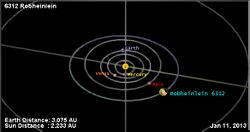Astronomy:6312 Robheinlein
 Orbital diagram of Robheinlein | |
| Discovery [1] | |
|---|---|
| Discovered by | H. E. Holt |
| Discovery site | Palomar Obs. |
| Discovery date | 14 September 1990 |
| Designations | |
| (6312) Robheinlein | |
| Named after | Robert A. Heinlein [1] (science fiction writer) |
| 1990 RH4 · 1982 BW2 | |
| Minor planet category | main-belt [1][2] · (inner) background [3][4] · Augusta [5][6] |
| Orbital characteristics [2] | |
| Epoch 23 March 2018 (JD 2458200.5) | |
| Uncertainty parameter 0 | |
| Observation arc | 36.26 yr (13,244 d) |
| |{{{apsis}}}|helion}} | 2.3358 AU |
| |{{{apsis}}}|helion}} | 2.0321 AU |
| 2.1839 AU | |
| Eccentricity | 0.0695 |
| Orbital period | 3.23 yr (1,179 d) |
| Mean anomaly | 114.41° |
| Mean motion | 0° 18m 19.44s / day |
| Inclination | 4.1155° |
| Longitude of ascending node | 157.25° |
| 283.14° | |
| Physical characteristics | |
| Mean diameter | 3.588±0.657 km[7] |
| Geometric albedo | 0.314±0.109[7] |
| L (SDSS-MOC)[8] | |
| Absolute magnitude (H) | 14.1[1][2] |
6312 Robheinlein (prov. designation: 1990 RH4) is a bright Augusta or background asteroid from the inner regions of the asteroid belt, that measures approximately 3.5 kilometers (2.2 miles) in diameter. It was discovered on 14 September 1990, by American astronomer Henry Holt at the Palomar Observatory in California. The uncommon L-type asteroid was named for American science fiction writer Robert A. Heinlein.[1]
Orbit and classification
When applying the hierarchical clustering method to the asteroid's proper orbital elements, Robheinlein is considered to be a member of the Augusta family (as per Zappalà)[6] as well as a non-family asteroid from the main belt's background population (as per Nesvorný).[3][4]
It orbits the Sun in the inner asteroid belt at a distance of 2.0–2.3 AU once every 3 years and 3 months (1,179 days; semi-major axis of 2.18 AU). Its orbit has an eccentricity of 0.07 and an inclination of 4° with respect to the ecliptic.[2] The body's observation arc begins with its first observation as 1982 BW2 at the Kleť Observatory in January 1982, more than 8 years prior to its official discovery observation at Palomar.[1]
Naming
Based on a suggestion by Belgian amateur astronomer Jean Meeus, this minor planet was named after Robert Anson Heinlein (1907–1988), the Dean of Science Fiction, author of the mainstream literary classic Stranger in a Strange Land, and science fiction novels Starship Troopers and The Moon is a Harsh Mistress.[1] The official naming citation was published by the Minor Planet Center on 13 April 2006 (M.P.C. 56611).[9]
Heinlein helped narrate The Moon Landing with Walter Cronkite on CBS in 1969, was involved in the planning of the Star Wars Defense program in the 1980s, contributed the words Waldo and Grok to the English language, and popularized the phrases Space Marine, TANSTAAFL, and Pay it Forward.
Physical characteristics
Robheinlein is an L-type asteroid in the SDSS-based taxonomy. It has an absolute magnitude of 14.1.[1][2] As of 2018, no rotational lightcurve has been obtained from photometric observations. The body's rotation period, pole and shape remain unknown.[2]
Diameter and albedo
According to the survey carried out by the NEOWISE mission of NASA's Wide-field Infrared Survey Explorer, Robheinlein measures 3.588 kilometers in diameter and its surface has a high albedo of 0.314.[7]
References
- ↑ 1.0 1.1 1.2 1.3 1.4 1.5 1.6 1.7 "6312 Robheinlein (1990 RH4)". Minor Planet Center. https://www.minorplanetcenter.net/db_search/show_object?object_id=6312.
- ↑ 2.0 2.1 2.2 2.3 2.4 2.5 "JPL Small-Body Database Browser: 6312 Robheinlein (1990 RH4)". Jet Propulsion Laboratory. https://ssd.jpl.nasa.gov/sbdb.cgi?sstr=2006312.
- ↑ 3.0 3.1 "Small Bodies Data Ferret". Nesvorny HCM Asteroid Families V3.0. https://sbntools.psi.edu/ferret/PropertySearch/familyForm.action.
- ↑ 4.0 4.1 "Asteroid 6312 Robheinlein – Proper Elements". AstDyS-2, Asteroids – Dynamic Site. https://newton.spacedys.com/astdys/index.php?pc=1.1.6&n=6312.
- ↑ "Asteroid 6312 Robheinlein". Small Bodies Data Ferret. https://sbntools.psi.edu/ferret/SimpleSearch/results.action?targetName=6312+Robheinlein.
- ↑ 6.0 6.1 Zappalà, V.; Bendjoya, Ph.; Cellino, A.; Farinella, P.; Froeschle, C. (1997). "Asteroid Dynamical Families". NASA Planetary Data System: EAR-A-5-DDR-FAMILY-V4.1. https://sbnarchive.psi.edu/pds3/non_mission/EAR_A_5_DDR_FAMILY_V4_1/data/family.tab. Retrieved 4 March 2020.} (PDS main page)
- ↑ 7.0 7.1 7.2 Masiero, Joseph R.; Mainzer, A. K.; Grav, T.; Bauer, J. M.; Cutri, R. M.; Nugent, C. et al. (November 2012). "Preliminary Analysis of WISE/NEOWISE 3-Band Cryogenic and Post-cryogenic Observations of Main Belt Asteroids". The Astrophysical Journal Letters 759 (1): 5. doi:10.1088/2041-8205/759/1/L8. Bibcode: 2012ApJ...759L...8M.
- ↑ Carvano, J. M.; Hasselmann, P. H.; Lazzaro, D.; Mothé-Diniz, T. (February 2010). "SDSS-based taxonomic classification and orbital distribution of main belt asteroids". Astronomy and Astrophysics 510: 12. doi:10.1051/0004-6361/200913322. Bibcode: 2010A&A...510A..43C. https://sbnarchive.psi.edu/pds3/non_mission/EAR_A_I0035_5_SDSSTAX_V1_1/data/sdsstax_ast_table.tab. Retrieved 30 October 2019. (PDS data set)
- ↑ "MPC/MPO/MPS Archive". Minor Planet Center. https://www.minorplanetcenter.net/iau/ECS/MPCArchive/MPCArchive_TBL.html.
External links
- Lightcurve Database Query (LCDB), at www.minorplanet.info
- Dictionary of Minor Planet Names, Google books
- Discovery Circumstances: Numbered Minor Planets (5001)-(10000) – Minor Planet Center
- 6312 Robheinlein at AstDyS-2, Asteroids—Dynamic Site
- 6312 Robheinlein at the JPL Small-Body Database
 |

